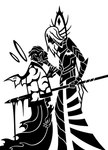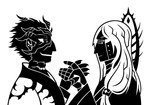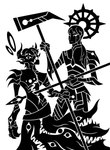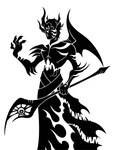
Species: daeva (scp foundation)
Daeva (singular daev, alternatively pluralized as daevas) are an archaic human species and a group of interest from the mythos of the SCP Foundation website. Daeva were first mentioned in SCP-140 — An Incomplete Chronicle (posted in April 2010 by AssertiveRoland) and described in numerous other entries and tales on the website, but wouldn't be given a hub page listed among others on the Groups of Interest page until December 2021. They are loosely based off of the daevas of Zoroastrianism, in which they are supernatural beings roughly equivalent to demons.
The daeva (Homo sanguinus) are an extinct member of the genus Homo from central Asia, originating within the southern reaches of what is now Siberia. The daeva were reminiscent of modern humans (Homo sapiens sapiens), and could even interbreed with them, but had their distinctions both physiologically and culturally.
Daeva society existed by the time of the 10th millennium BCE, starting as a loosely connected series of city-states with shared cultural practices and religion that unified under an imperial rule known as the Daevite Empire. With the daeva comprising the aristocracy, the Daevite Empire was ruled by several clans lead by matriarchs of both political and religious importance, who subjugated those from the male daeva to the enslaved people of the daeva's conquered lands; these were generally modern humans (H. s. sapiens), but even some bigfoot (H. s. noctis, SCP-1000) and their creations (ex. SCP-3140) were oppressed.
The daeva religion venerated life, blood, birth, and the material world, with no apparent concern or even concept of afterlife. Dancing was a tenet of their culture and staple of ritual practices, believed to be a means of communication with the primordial force of the universe, the "Font" (likely a cognate of Yaldabaoth). Hypocritical when compared to the veneration of their own lives, the daeva had a brutal reputation, at they would often practice human sacrifice, smaller blood sacrifices, and even ritual cannibalism of their enemies. Various methods of torture were also inflicted on dissidents from the lower classes, with castration, tongue removal, and sewing of the mouths shut being favored examples of the matriarchs' cruelties.
Anomalous in nature, the daeva were proficient in thaumaturgy, namely practicing blood magic and plant manipulation in their worship of life, maintenance and modification of the body, and conquest of enemies. Some daeva also had the capacity to perform rituals to manipulate time for the empire's gain (consequently, their culture had lack of respect for the concept of time and occasion), using them to increase the longevity of their species and society. Due to those practices, the daeva civilization has been enigmatic for anthropologists. They may also have some involvement in the origins of the hecatoncheires (SCP-3743-C).
At its height, the Daevite Empire spanned throughout most of Central Asia, the Middle East, and Eastern Europe. However, the daeva civilization entered its decline during the Bronze Age, in the wake of a revolution led by a powerful sorcerer and prophet named Ion, who was rumored to have been a half-breed born into slavery after a daeva matriarch conceived with one of her human concubines. During the 18th century BCE, the Daevite capital was overtaken and a new empire arisen by Ion and his four apostles, the Klavigars.
Despite great losses, the remnants of the Daevite Empire persisted, in part due to rituals and artifacts of theirs that have altered their history and prolonged their longevity. One such artifact, SCP-140, brought the daeva to the attention of the SCP Foundation, for which they have been a significant concern. SCP-140 and resulting archeological evidence indicated that by the time of the former's discover, the daeva were eradicated in the 3rd century BCE by Zhou dynasty General Qin Kai; however breaches by SCP-140 and other artifacts have changed it so the daeva survived until their massacre by Ghengis Khan and his fledging Mongol army at the turn of the 13th century CE.
External Links
Posts (view all)



